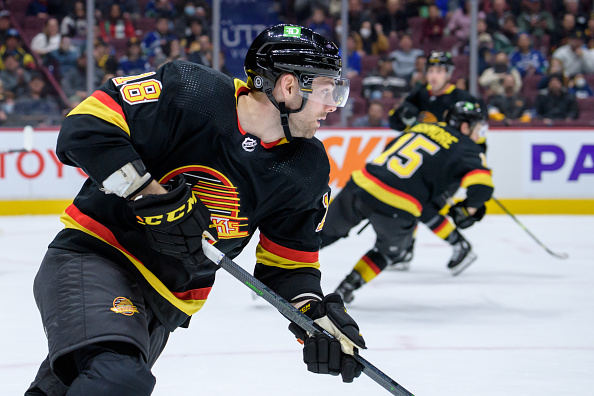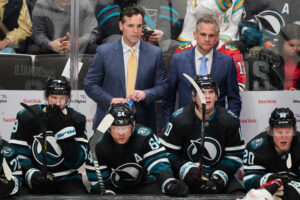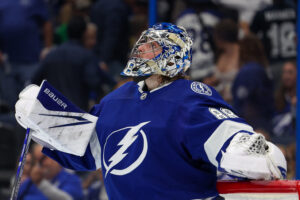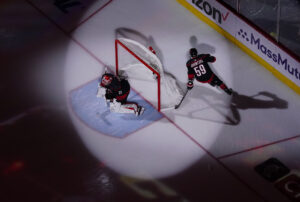Jason Dickinson wasn’t THE problem for the Vancouver Canucks in 2021-22, but he sure wasn’t the answer, either.
The Good Intentions of Jason Dickinson
We’re not telling secrets out of school to say that the 2021-22 Vancouver Canucks season was not a great one. Yes, there were win streaks and J.T. Miller brushing triple digits and nearly reaching the playoffs and a charmingly bewildered head coach and all that. But a team doesn’t overhaul their coaching and management staff in a good year.
Part of the problem* was optimism. Not only was a HUGE deal consummated, but two of the team’s cornerstone players reached contract deals. With Elias Pettersson and Quinn Hughes in the fold, there were no player questions to hang over the team all season. Okay, there was one, but only having Brock Boeser scheduled to be an RFA was much better than what could have been.
An ongoing difficulty for the Canucks, year after year, was the bottom-six. Overpaid and underskilled, they were an anchor on a decent top-of-the-lineup. Out of desperation, general manager Jim Benning completely revamped the team in three deals. One was, of course, the Oliver Ekmann-Larsson and Conor Garland trade; another brought in Juho Lammikko from the Florida Panthers; the third won the signing rights to Jason Dickinson from the Dallas Stars.
They wasted little time signing him to his current three-year deal, both sides seeming quite happy about it. For Dickinson, it was a stable and clearly-defined role, leading the penalty kill and playing against top-level opponents. It was a position the team was hoping Brandon Sutter could fill, but his post-COVID relapse prevented Sutter from playing at all in 2021-22. Instead, they brought on Dickinson, who could get a few points and play a big part in shutting down opponents. That, in turn, would free up Bo Horvat to be primarily an offensive threat at last.
Best Laid Plans
It just didn’t work. As with Dallas, Dickinson fell into a nowhere land of doing reasonably well higher up in the lineup and never finding a good match lower where the team wanted to use him. His production dragged mightily until the last month of play – five of his 11 points came in April. He prevented goals well enough at five-on-five. The problem was that he was an anchor on his linemates’ offence. When he lined up with Vasili Podkolzin and Conor Garland or Bo Horvat, they reduced chances on both sides of the ice. Perfect if you’re the third or fourth line, not so great when you need to score.
Frankly the less said about the Vancouver Canucks’ early penalty kill the better. It was pointed directly at the league’s worst, and an all-time record for futility in Canucks history until the changeover. Given that Dickinson’s role was promoted as his ability on the penalty kill, that’s not a great look. The team did manage to drag themselves up to nearly 75% by season’s end, at least. And he did get some points late – even if three of those five points came in one game against his former team. They still count!
Now What for Jason Dickinson?
It’s not completely unfair to say that for Dickinson, his first year in Vancouver was a disaster. Some damage to a player’s Corsi isn’t entirely unexpected for a player assigned to hard matches, but his 43% isn’t close to what’s needed. He got caved in on faceoffs, something you want your defensive centre to master.
However, he did tighten his came up after returning from injury. With Tyler Motte gone thanks to a trade, there is an opportunity for him. He has some of the size and speed the Canucks generally lack, can play wing and centre, and has a lot to make up for. If Dickinson doesn’t go into 2022-23 driven by the sheer embarrassment of cashing last year’s paycheques then there really is no hope for him. He has some skills – he wasn’t a first-round pick by accident – and last season was a lot of chaos for Vancouver. He could well come back to a decent level. Or at least better than this mess.
That all is counterbalanced by whether losing him would be an advantage for Vancouver. After last season, we can’t see a team wanting to trade for him, especially at his $2.65 million cap hit. Oh, and as is the regular sign of the COVID signings, the actual cash value increases. His actual salary is $2.7 million this season, $3.25 million next. Any trade is going to be, at best, for a player another team doesn’t want at close to the same cap. The gamble is whether that new player will – or can – be an improvement. He is relatively young at 26 and has a long playoff run in his pocket, but that hardly seems like enough.
Apologies for the Flashbacks
He is one player the Canucks have for whom a buyout can be a valid option. His only signing bonus has been paid, so the team will only be on the hook for his discounted remaining salary. That’s just under $1 million in 2022-23, 2024-25, and 2025-26. It dips to $391K in 2023-24 because buyouts are weird. This isn’t a great option, of course, as the team will be dealing with the Jake Virtanen and Braden Holtby buyouts as well. But they are only in place for next season, then are gone. Adding Dickinson to that list drops the cap hit for the Canucks by $1.7 million in 2022-23. Yes, he’ll have to get replaced, but given his production so far? It’s an area the team might be fine with taking a chance on a free agent, for one year, at least.
The team may well decide to simply ride out next year, too. Especially if Tucker Poolman‘s concussion issues prevent him from playing, the Canucks can take Jason Dickinson’s cap hit into their long-term injured reserve space. It means they’ll need to get as close to the upper limit as they can come opening night before applying for cap relief, and an inefficient contract like Dickinson’s becomes less of a burden. Sitting in LTIR cap relief stops a team from accumulating cap space, though to use later in the year. It’s always best to avoid long-term cap relief if possible.
Options, Options, Everywhere
…and none of them good. Dickinson’s play last season was barely at replacement-level while drawing an NHL-level salary. It’s a one-way deal, too, so there isn’t even any money to be saved by sending him down to Abbotsford. The team can save some cap space putting him in the AHL, but they’d save more buying him out. And with two seasons to go, they can’t even shop him as a rental. It’s an ugly situation for both team and player.
While there aren’t any good options here, the least damaging might be to wait it out. Hope that the newly-stable management situation trickles down to the players and Dickinson either finds his game or coach Bruce Boudreau finds a way to use him that works for everyone. If not, fans may be seeing Jason Dickinson at the bottom of the Canucks’ CapFriendly page for a few more years.
*among others, but let’s keep focus here, people!






